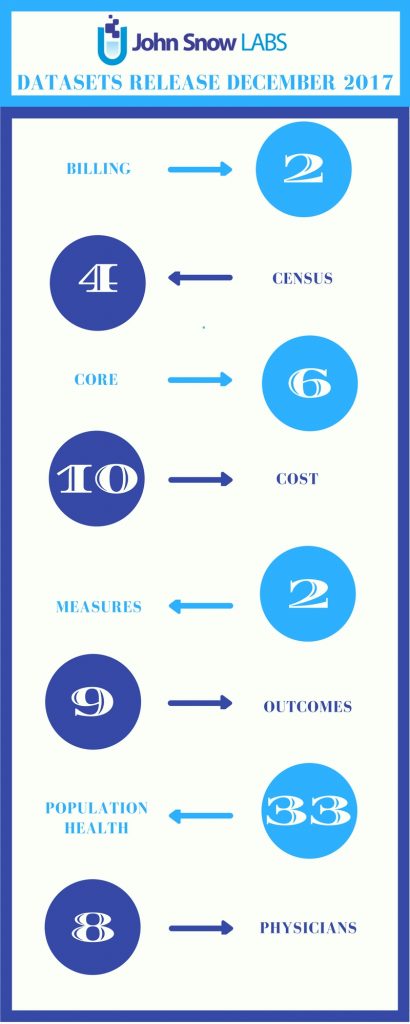John Snow Labs’ Dec-2017 Data Catalog:
74 New Datasets from Level III Alpha-Numeric 2018 HCPCS, IP Revenue Crosswalk Codes, Medicare Utilization Indicators and Physicians Utilization and Payment Data, National Survey on Drug Use, NOHSS and OECD Countries Health Data, and more
In this 2017 year-end release, you will have access to critical datasets that have passed the three-layer quality review and 100% automated validation measures; the goal is to help you with your 2018 healthcare predictive data analytics.
The John Snow Labs’ team has curated 74 fresh healthcare datasets including the 2018 Level III Alpha-Numeric Healthcare Common Procedure Coding System, which showcases a collection of codes that represent non-physician services not covered by the American Medical Association’s CPT-4 such as procedures, supplies, products and services but are still provided by Medicare to beneficiaries and to individuals who are enrolled in private health insurance programs.
IP Revenue Crosswalk Codes, on the other hand, is used to group similar types of codes according to descriptions and dollar amounts charged for hospital services provided to patients. If you are an insurance company, these codes will help you in classifying whether a claim for a procedure was performed in the emergency room, operating room or another department. This information is vital in determining the actual cost for a claim or reimbursement for your company.
If you are, however, in the arena of public governance, John Snow Labs has curated 6 datasets for the Medicare Utilization Indicators by Geographic Variations and 6 datasets on Medicare Physicians Utilization and Payment Data that will help you aggregate the datasets we have into a Geographic Variation Public Use File that has demographic, spending, utilization, and quality indicators at the state level, hospital referral region (HRR) level, and county level. This data will enable researchers and policymakers to evaluate geographic variation in the utilization and quality of healthcare services for the Medicare fee-for-service population.
In this release, we continued to grow a mix of our domain expertise from 33 datasets for population health from OECD Countries Health Indicators, Mortality and Morbidity Data, Life Expectancy and Mental Health Data, National Survey on Drug Use and Health among others. This will give researchers and data scientists a good visualization of the distribution of clinical and health outcomes within specific groups of people that will eventually help improve the goals of improving population health.
Clinical Outcomes has added 9 datasets from Behavioral Risk Factor Health and Diseases Surveillance System on Quality of Life and Aging Data. National Oral Health Surveillance System has data on Child and Adult Indicators; plus, Water Fluoridation System at the State and National levels.
New York City Population, State Government Tax, US International Trade in Goods and Services are among the 4 datasets that were added to Census catalog. 1 dataset on Electric Vehicle Charging Network for Transportation and 6 datasets for Austin Health Data were added to the Open Knowledge catalog as well. Lastly, 2 datasets for Clinical Measures are added for Austin Airport Annual Performance Measures and Federal Deposit Insurance Corporation Failed Bank List.
For abetter appreciation of the 74 datasets we have carefully put together in this release, here’s an infographic to represent a visual image of our datasets:
The ongoing evolution of healthcare data usage is pivotal; leveraging Generative AI in Healthcare and advancements in Healthcare Chatbot technology can further enhance patient care and data management strategies.






























